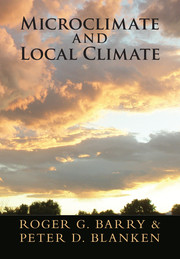12 - Climate Change and Microclimate
from Part III - Environmental Change
Published online by Cambridge University Press: 05 May 2016
Summary
Global climate has undergone major changes over the last century. Mountain glaciers have retreated worldwide, exposing new land areas, and biomes have shifted their boundaries poleward and upward. Global temperatures have risen by almost 1 °C since the 1880s and in high northern latitudes the warming has been amplified several-fold. The atmospheric concentration of carbon dioxide increased by almost 40 percent from about 290 ppm in 1900 to 400 ppm in 2015. Atmospheric methane increased since 1750 by 250 percent to 1800 ppb. How these changes have affected microclimates is the topic of this chapter. We begin with an overview of the major changes that have been observed in the climate system.
Overview of Global Trends
Global climate is determined by a combination of natural processes and human impacts on the climate system. Natural variability on decadal to century timescales is a result of variations in solar output, volcanic eruptions, air–sea interactions, and atmospheric variability. Solar variability occurs during the solar cycle, which lasts about 11 years on average. Between solar maximum and minimum, total solar output varies by 1.3 W m−2, or 0.1 percent. However, there are larger variations in the UV spectrum. Lean et al. (1997) calculate that the variability is 1.1 percent in the 0.2–0.3 μm range and 0.25 percent in the 0.3–0.4 μm range. Counterintuitively, sunspots (cooler, darker areas on the Sun's photosphere) increase in number toward a solar maximum because the bright faculae that surround the spots are more numerous, increasing the solar output. Explosive volcanic eruptions, especially those occurring in the tropics, force fine ash and sulfur dioxide (SO2) particles into the stratosphere, where they circle the globe. These exert a cooling effect in the subsequent two to three years, lowering average temperatures significantly, particularly in the boreal summers. Sigi et al. (2015) analyze ice cores from Greenland and Antarctica for ash and SO2 signatures over the last 2500 years and correlate these with tree ring data. They find that the 5 year average cooling in three regions of the Northern Hemisphere was –0.6 °C for the 19 largest tropical eruptions in the Common Era (CE). Two very large events in the decade 530s CE led to departures in European temperatures of –1.6 to –2.5 °C and –1.4 to –2.7 °C. Cold conditions from the second event persisted for almost a decade.
Information
- Type
- Chapter
- Information
- Microclimate and Local Climate , pp. 277 - 290Publisher: Cambridge University PressPrint publication year: 2016
